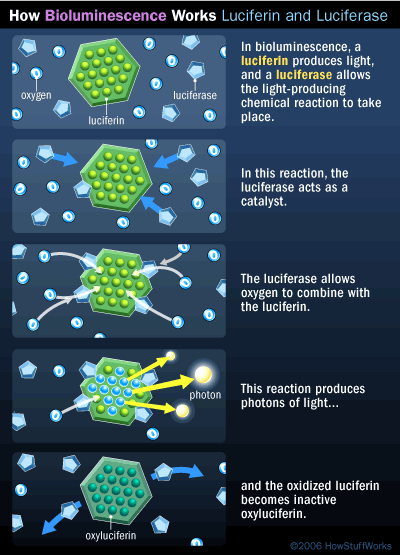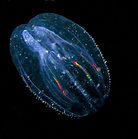Luminescence
Bioluminescence
Bioluminescence is the most well-known and popular type of Chemiluminescence and involves the process itself occuring within a living organism. The light emitted is considered "cold", and does not involve the release of physical heat. This phenomenon can occur as a method of self-defence, a way to lure prey, or even a way to find a mate for reproduction. Bioluminescent organisms are most commonly marine, although there are also multiple examples of terrestrial organisms that carry out bioluminescence
How does it work?
Bioluminescence is the result of a specific biochemical mechanism that can involve multiple chemical processes. It is often specific to the type of organism, although all bioluminescent reactions result in the emission of light.

Fireflies
(Lampyridae)
Fireflies are winged insects that are commonly seen on summer nights.
REACTION
Fireflies have organs in their bodies dedicated to the production of light through chemical reactions. These organs store a substance called luciferin (C11H8N2O3S2) which combines with oxygen that is taken in by the insects and this reaction produces light.
REASON
Fireflies are able to flash the light emitted in particular patterns which allows them to attract potential mates. The luminescence also serves as a defence mechanism which warns potential predators of the unappetizing taste.

Plankton
(Dinoflagellates)
Dinoflagellates are a particular species of plankton that produce a green/blue light when the water they are living in is disturbed by motion.
REACTION
The reaction that takes place in Dinoflagellates is similar to the reaction seen in fireflies. It is an oxidation reaction that involves a reaction between oxygen and a substrate (Luciferin). The oxygen oxidizes the luciferin, and the reaction is made more efficient with the presence of luciferase (an enzyme that acts as a catalyst).
REASON
Scientists believe that Dinoflagellates use their flashes of light as a mechanism to scare away predators. They also believe that the luminescence attracts larger predators, which can also assist in threatening the predators of the Dinoflagellates themselves.


Comb Jellies (Ctenophores)
REACTION
Comb Jellies contain a special protein in some of their tissues that undergo a chemical reaction which produces blue/green light. The Calcium-activated protein releases energy in the form of light when the Calcium ions bond to the protein, thus changing its shape. These proteins also contain luciferin of a very high energy level and oxygen which provide the energy for the reaction to take place. So, when the Calcium ions bond to the protein, the invested energy is release in the form of light, which gives the Comb Jellies their glow.
REASON
Although no one knows exactly why Comb Jellies have this property, it is believed to be a defence tactic as their bright flashes of light are easily able to scare away predators

Graphic representation of the unique photoprotein found in Comb Jelly tissue.